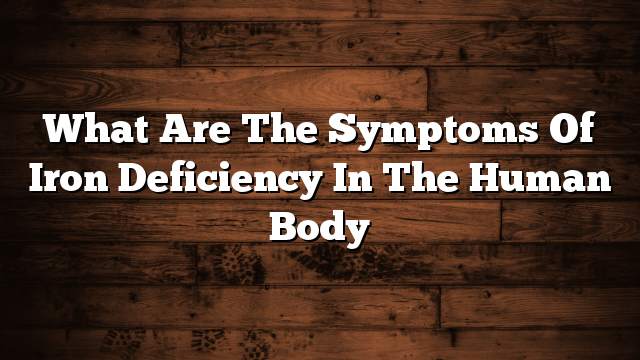Iron deficiency
Iron is found naturally in many foods, as well as in other foods, and is also available in the form of food supplements. The human body needs iron because it is essential for the growth and development of the human body. It is also important for the functions of the body’s cells and for the production of certain hormones and tissues in the body. Iron is necessary for the production of hemoglobin, a part of red blood cells that can be likened to taxis to transport oxygen Carbon dioxide, where the hemoglobin picks up oxygen from the lungs and passes it through the blood stream, then connects it to the different tissues of the body so that the cells can produce energy and then capture carbon dioxide from the cells to transport it to the lungs and get rid of it. Of foods; however, many people do not get enough of their daily needs.
Symptoms of iron deficiency
Iron deficiency anemia is a major concern in the field of public health, especially in children and women of childbearing age. General fatigue is the most common sign of iron deficiency; its symptoms appear only on the human body when it develops into iron deficiency anemia, Iron stores are very low, so you can not manufacture enough red blood cells to transport oxygen efficiently. These symptoms include:
Iron deficiency anemia can become severe and lead to various health problems such as:
- Heart problems.
- Problems during pregnancy, such as premature birth and low birth weight.
- Problems in children’s growth. Iron deficiency in infants and children can lead to mental, motor, and psychological abnormalities. Failure to address the deficiency can lead to learning difficulties. Iron deficiency is often accompanied by a lack of nutrients It is difficult to separate the signs and symptoms of iron deficiency from the lack of other nutrients, so consult your doctor and perform appropriate tests after consulting him.
The most vulnerable groups are iron deficiency
Some groups are at greater risk when iron deficiency occurs. These include:
- Pregnant or breastfeeding women: Because of increased blood volume, so the pregnant woman needs a larger amount of iron to transport oxygen to the fetus.
- Young children: Children have sufficient reserves of iron up to 6 months of age. Their iron needs are increased. Milk and milk fortified with iron do not provide enough. Children should be fed six months later. Bovine Poor intake of iron, and eating a large amount of milk is a problem that may impede the absorption of iron in other foods, leading to anemia, and drinking two cups of milk a day sufficient for children aged one to three years.
- Teen girls: Inadequate diets, often dependent on deprivation and rapid growth at this stage, expose girls at this age to the risk of iron deficiency anemia.
- Women of reproductive age: Women with severe menstrual periods can experience iron deficiency.
- Blood donors frequently: This is because blood donation drains iron stores in the human body.
- Vegetarians: People who do not eat meat are more likely to have iron deficiency.
- People exposed to blood loss due to certain diseases: Such as ulcers and colon cancer.
Iron sources
As mentioned previously, there are many dietary sources of iron in human food, and have been divided into two parts as follows:
- Animal Resources: The iron found in animal sources is absorbed by the body better, and used more effectively in the human body, for example:
- the meat.
- Fish.
- Chicken.
- Plant sources: The absorption of iron from plant sources is less efficient than its absorption from animal sources. Examples of plant sources of iron include the following:
- Legumes: such as beans and lentils.
- Dark green leafy vegetables: like spinach.
- Dried fruits: such as raisins and apricots.
- Iron-fortified cereals and iron-fortified bread.
- The peas.
The human body needs iron
In the following table, the average daily requirement of iron to meet the nutritional needs of healthy people:
| Age | Male | female |
|---|---|---|
| 3-1 years | 7 mg | 7 mg |
| 8-4 years | 10 mg | 10 mg |
| 13-9 years | 8 mg | 8 mg |
| 18-14 years | 11 mg | 15 mg, pregnant 27 mg, breastfeeding 10 mg |
| 50-19 years | 8 mg | 18 mg, pregnant 27 mg, nursing 9 mg |
| 50 years and over | 8 mg | 8 mg |
Avoid iron deficiency
To avoid iron deficiency, a person must get enough of it, by:
- Eat a healthy and balanced diet; By selecting a variety of food from both vegetable and animal exporters.
- Eat plant iron sources with vitamin C in the same meal; Because vitamin C helps absorb iron from plant sources, for example: lemon can be added to spinach and salad leafy vegetables, or eat cereals supported with citrus juice or strawberries.
